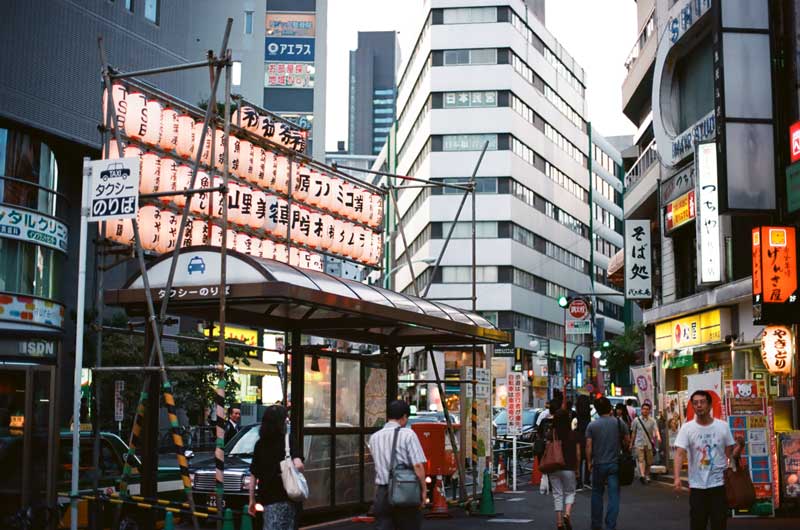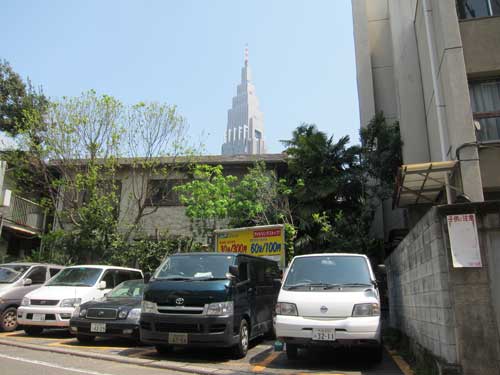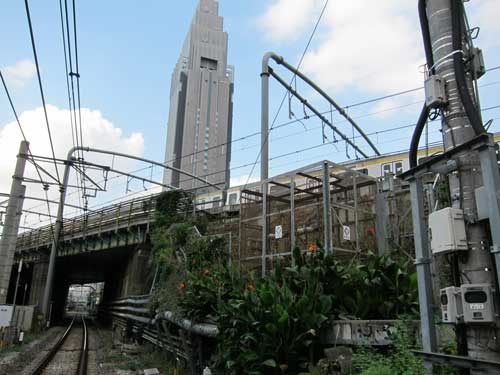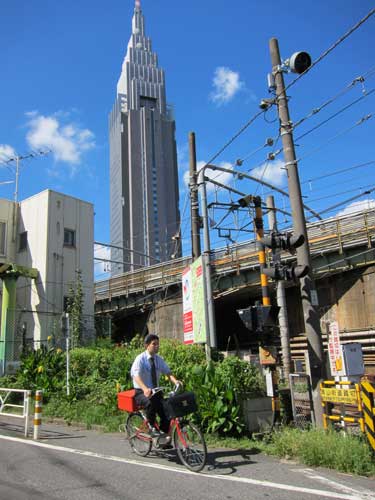
秋にケヤキの木は抽象芸術みたいです。
Zelkova, called keyaki in Japanese, is a super elegant street tree. I love the contrast between the dark bark and golden leaves.
Yoyogi
A very urban, summer scene, with yukata sidewalk party, Odakyu train, and office tower
Modern and baroque mix in narrow alley
Tanuki heats up ginkgo nuts and serves hot coffee next to the Yamanote line

Tanuki offers visitors from the Netherlands warm gingko nuts and hot espresso on a cold night in Yoyogi.
Bus stop turns into lantern scaffolding for fall festival

Urban layers with wild space in the middle of Tokyo

この代々木の写真には、風景が3つ見えます。この組み合わせはとても東京らしいです。
This image sums up my love of Tokyo green spaces. In the background is the iconic Docomo Tower in Shinjuku. In the foreground is a typical Tokyo sight: a lot where the old structure has been raised is now used for hourly parking. In the middle is an older residence whose wild garden is thriving through neglect and the absence of redevelopment. Tokyo is a dense place full of the iconic and prosaic, living nature and concrete structures, traces of the past and constant change.
Wildness in unused land by rail tracks

I have been thinking about the urban corridors and the distributed real estate that connect city people literally and experientially. Everything from rail lines that take us where we are going to convenience stores that make us feel that we are in the same place no matter where we are. Rail companies and retail chains own or operate so much real estate to make them second only to governments in terms of land ownership and possibilities for remaking our environment.
I love the chaotic, multi-directional rail lines in Yoyogi- two sets of elevated lines and street-grade lines taking traffic from Shinjuku to other parts of Tokyo, towns and resorts to the west, and across Japan. As a pedestrian, the rail crossings slow down your walk and make you aware of the millions of people circulating in Tokyo.
I’ve blogged before about the cool wildflowers with some unplanned cultivation on the sides of the tracks. The rail companies must be concerned about safety, including keeping neighbors safe and also minimizing garbage on the tracks. Yet it’s great that this land exists in a semi-wild state, and cool that it’s so accessible in Yoyogi. I wonder what further uses the lands beside rail tracks and stations could have in cities, suburbs, and countryside. Wildlife habitat, small farms, recreation, bee hives, or other uses.


Semi-wild, semi-cultivated space in Yoyogi

I noticed this interesting semi-wild, semi-cultivated space alongside a busy Yoyogi road and in between two train tracks, an elevated overpass, and a convenience store. It shows you what minimal effort and Tokyo’s abundant rain can do to create a space that is lush and full of summer flowers. I like the mix of wildness and anonymous stewardship. The results are such a contrast with poorly organized city efforts like this Shibuya Greening Project, documented by Chris on Tokyo DIY Gardening, which seem doomed to rapid failure.


